
1. Group A: Five students who answered most questions correctly.
1.1. They will be given an assignment to complete word problems. To ensure they understand the problems completely, they will be given multiple wordings. Then, to further their understanding and develop a real-world connection, they will have to write word problems giving real world situations. These word problems could then be used as an assignment later in the chapter.
1.1.1. Data tracking is relatively with a Playposit video using Kahn Academy or Mathantics. It can be directly compared to the previous test and my lesson can be evaluated based on the improvement.
2. Group B: 12 students who have some knowledge on the topic but have to develop higher order skills.
2.1. A two sided handout with an example and some simple questions on one side. On the other side there would be harder questions (like fractions where you would have to multiply both sides of the equation) and word problems. The answers in the word problems will give clues to a puzzle the students need to solve to get a reward.
2.1.1. Their progress could be mapped with the handout, and another Playposit video expanding on the previous one would enable be to directly monitor progress.
3. Group C: 5 Students who seem to have limited knowledge about the topic.
3.1. Manipulates would be key here, allowing the students to physically see and manipulate the materials in front of them. We will work back through simple fractions and try to reestablish a connection between a fraction and a whole. I also think comparing fractions would be helpful getting to actually think about how fractions work. We would then move into adding and subtracting like, and then, unlike fractions.
3.1.1. Methods for tracking the data: Again, a well organized and thought out Playposit video could help students review the material at home, with the parents. This could foster a healthy home work environment. It also allows me to directly measure my lesson's effectiveness my comparing the scores before and after the lessons.
3.1.2. 3 of these students have difficulty with the language and are at different language levels.
3.1.2.1. I will begin addressing these students 1 on 1. Additional Data tracking would have to be with McGraw-Hill worksheets from the workbook and online resources. Anything that is required could be selected and printed out immediately as the assessments come from an online database and we have a printer in the classroom.
3.1.2.2. Vocabulary sheets that go along with mathematics can be an invaluable tool to develop understanding. Using graphics with the vocabulary and having all of them in one place can be very helpful.
3.1.3. 2 students who have little to no comprehension of the the topic and need to be tested further for special needs.
3.1.3.1. I will continue to work 1 on 1 with these students after the 3 ELL students are working on their worksheets. These students will need close monitoring and data collection. After games on Mathplayground, I will ask the Taiwanese Mathematics teacher the student's level of understanding in other areas of mathematics. As she is a special-education specialist, she can advise me on methods of instruction, exercises, and realistic expectations.
3.1.3.1.1. Weekly quizzes and very small Playposit videos can be used to track scores and see where I need to either refocus my efforts or use a different method of instruction.

